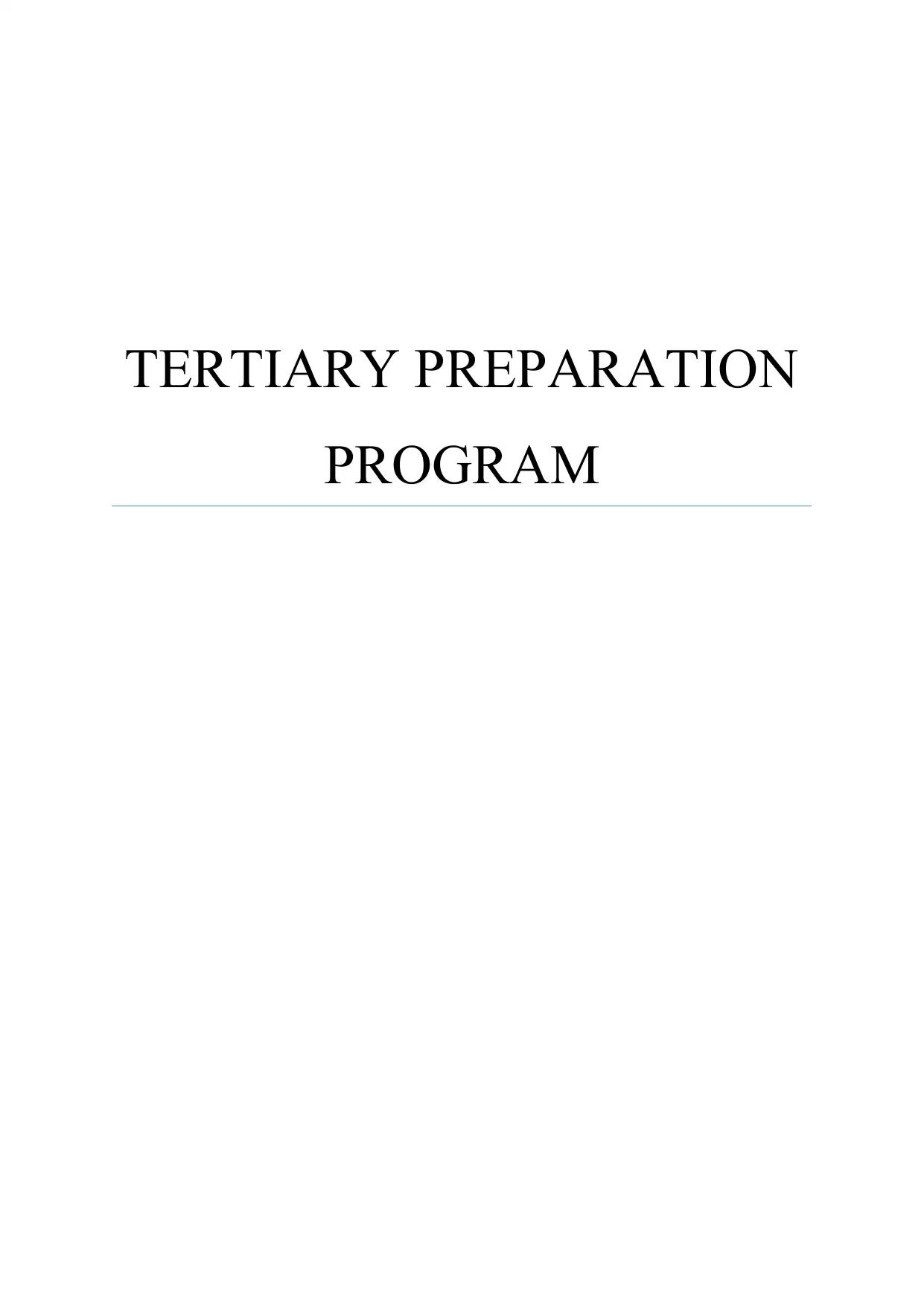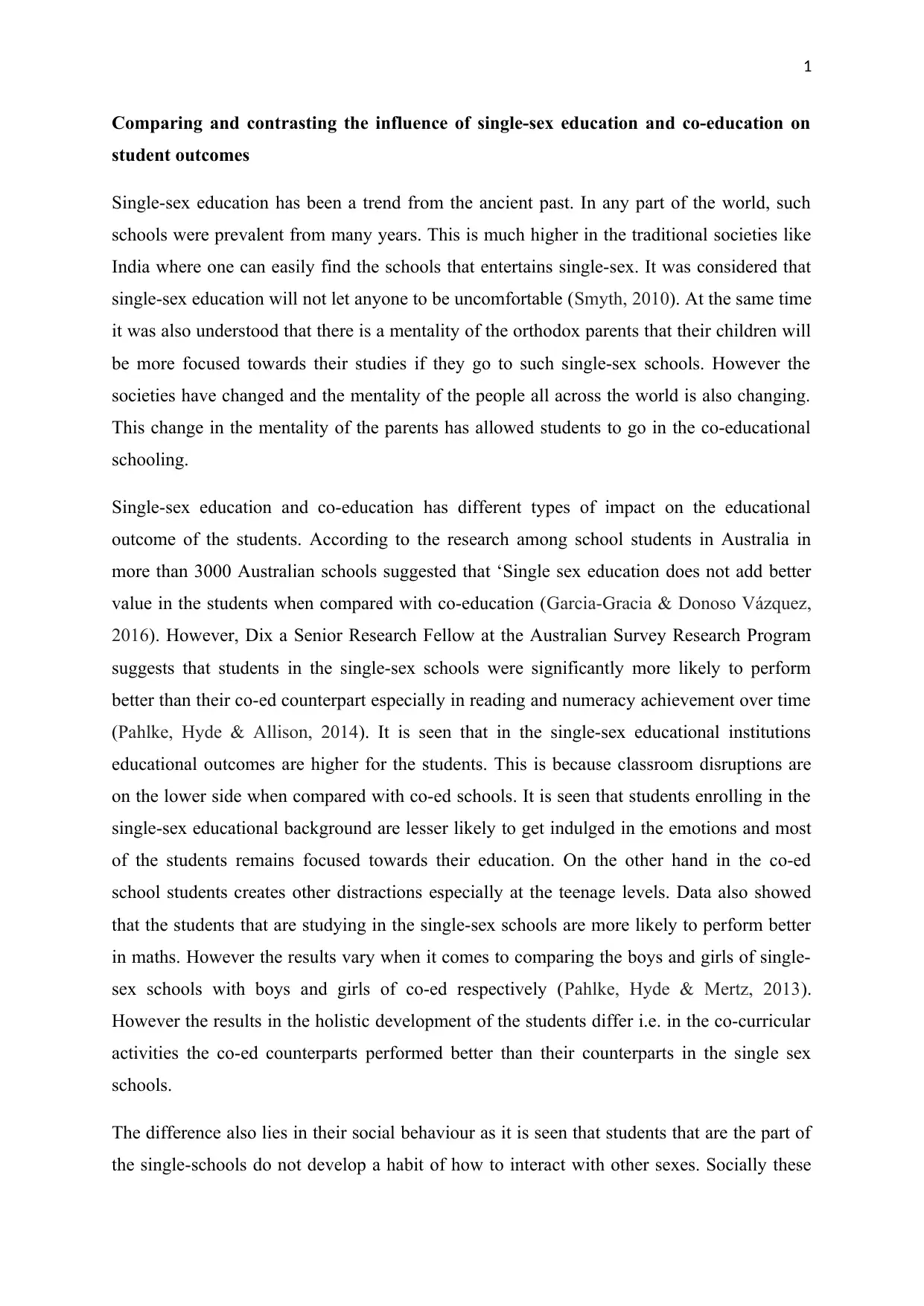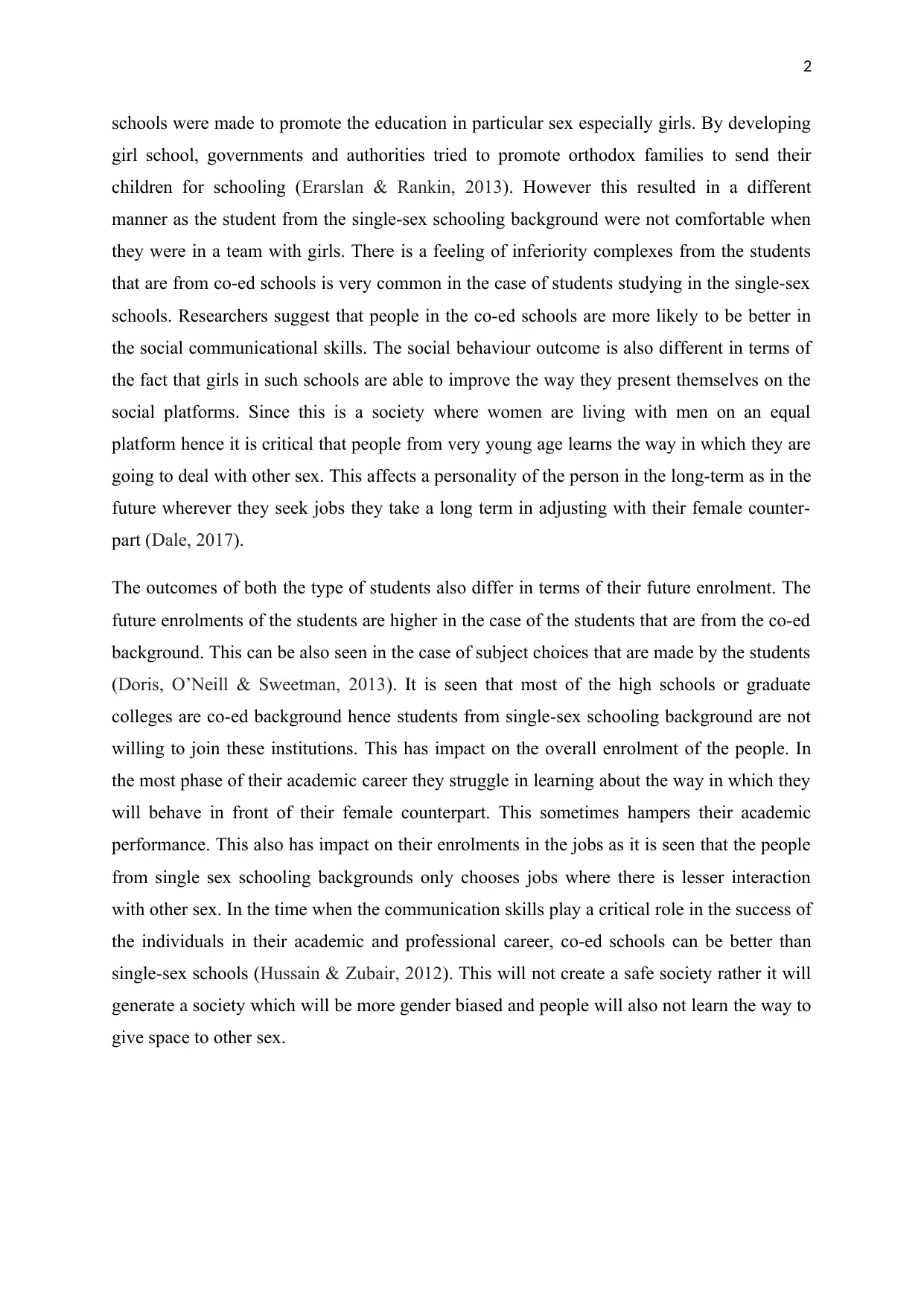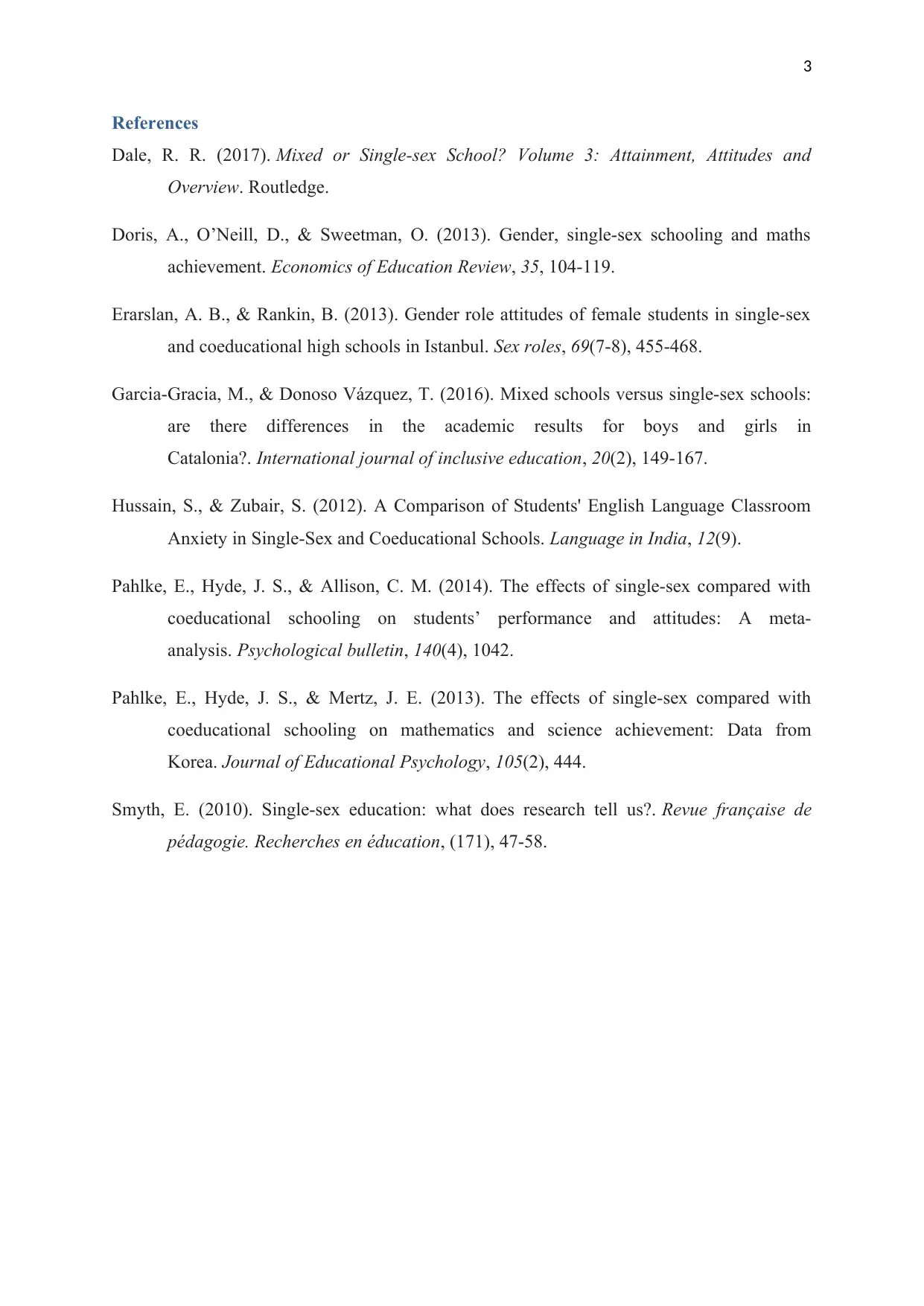TERTIARY PREPARATION PROGRAM: Single-Sex vs. Co-Education Outcomes
VerifiedAdded on 2022/10/07
|4
|1247
|30
Essay
AI Summary
This essay provides a comparative analysis of single-sex and co-educational schools, exploring their differing impacts on student outcomes. The study examines various aspects, including academic performance, social development, and future enrollment prospects. It highlights research findings suggesting that single-sex education may offer advantages in specific areas, such as classroom focus and certain academic subjects like mathematics, while co-education may foster better social and communication skills. The essay delves into the nuances of these educational environments, considering factors like classroom disruptions, student interactions, and the development of essential social behaviors. The analysis also considers the impact of these educational settings on future educational and professional choices of students. The conclusion emphasizes the importance of communication skills in today's world and suggests that co-educational schools could be more beneficial than single-sex schools.

TERTIARY PREPARATION
PROGRAM
PROGRAM
Paraphrase This Document
Need a fresh take? Get an instant paraphrase of this document with our AI Paraphraser

1
Comparing and contrasting the influence of single-sex education and co-education on
student outcomes
Single-sex education has been a trend from the ancient past. In any part of the world, such
schools were prevalent from many years. This is much higher in the traditional societies like
India where one can easily find the schools that entertains single-sex. It was considered that
single-sex education will not let anyone to be uncomfortable (Smyth, 2010). At the same time
it was also understood that there is a mentality of the orthodox parents that their children will
be more focused towards their studies if they go to such single-sex schools. However the
societies have changed and the mentality of the people all across the world is also changing.
This change in the mentality of the parents has allowed students to go in the co-educational
schooling.
Single-sex education and co-education has different types of impact on the educational
outcome of the students. According to the research among school students in Australia in
more than 3000 Australian schools suggested that ‘Single sex education does not add better
value in the students when compared with co-education (Garcia-Gracia & Donoso Vázquez,
2016). However, Dix a Senior Research Fellow at the Australian Survey Research Program
suggests that students in the single-sex schools were significantly more likely to perform
better than their co-ed counterpart especially in reading and numeracy achievement over time
(Pahlke, Hyde & Allison, 2014). It is seen that in the single-sex educational institutions
educational outcomes are higher for the students. This is because classroom disruptions are
on the lower side when compared with co-ed schools. It is seen that students enrolling in the
single-sex educational background are lesser likely to get indulged in the emotions and most
of the students remains focused towards their education. On the other hand in the co-ed
school students creates other distractions especially at the teenage levels. Data also showed
that the students that are studying in the single-sex schools are more likely to perform better
in maths. However the results vary when it comes to comparing the boys and girls of single-
sex schools with boys and girls of co-ed respectively (Pahlke, Hyde & Mertz, 2013).
However the results in the holistic development of the students differ i.e. in the co-curricular
activities the co-ed counterparts performed better than their counterparts in the single sex
schools.
The difference also lies in their social behaviour as it is seen that students that are the part of
the single-schools do not develop a habit of how to interact with other sexes. Socially these
Comparing and contrasting the influence of single-sex education and co-education on
student outcomes
Single-sex education has been a trend from the ancient past. In any part of the world, such
schools were prevalent from many years. This is much higher in the traditional societies like
India where one can easily find the schools that entertains single-sex. It was considered that
single-sex education will not let anyone to be uncomfortable (Smyth, 2010). At the same time
it was also understood that there is a mentality of the orthodox parents that their children will
be more focused towards their studies if they go to such single-sex schools. However the
societies have changed and the mentality of the people all across the world is also changing.
This change in the mentality of the parents has allowed students to go in the co-educational
schooling.
Single-sex education and co-education has different types of impact on the educational
outcome of the students. According to the research among school students in Australia in
more than 3000 Australian schools suggested that ‘Single sex education does not add better
value in the students when compared with co-education (Garcia-Gracia & Donoso Vázquez,
2016). However, Dix a Senior Research Fellow at the Australian Survey Research Program
suggests that students in the single-sex schools were significantly more likely to perform
better than their co-ed counterpart especially in reading and numeracy achievement over time
(Pahlke, Hyde & Allison, 2014). It is seen that in the single-sex educational institutions
educational outcomes are higher for the students. This is because classroom disruptions are
on the lower side when compared with co-ed schools. It is seen that students enrolling in the
single-sex educational background are lesser likely to get indulged in the emotions and most
of the students remains focused towards their education. On the other hand in the co-ed
school students creates other distractions especially at the teenage levels. Data also showed
that the students that are studying in the single-sex schools are more likely to perform better
in maths. However the results vary when it comes to comparing the boys and girls of single-
sex schools with boys and girls of co-ed respectively (Pahlke, Hyde & Mertz, 2013).
However the results in the holistic development of the students differ i.e. in the co-curricular
activities the co-ed counterparts performed better than their counterparts in the single sex
schools.
The difference also lies in their social behaviour as it is seen that students that are the part of
the single-schools do not develop a habit of how to interact with other sexes. Socially these

2
schools were made to promote the education in particular sex especially girls. By developing
girl school, governments and authorities tried to promote orthodox families to send their
children for schooling (Erarslan & Rankin, 2013). However this resulted in a different
manner as the student from the single-sex schooling background were not comfortable when
they were in a team with girls. There is a feeling of inferiority complexes from the students
that are from co-ed schools is very common in the case of students studying in the single-sex
schools. Researchers suggest that people in the co-ed schools are more likely to be better in
the social communicational skills. The social behaviour outcome is also different in terms of
the fact that girls in such schools are able to improve the way they present themselves on the
social platforms. Since this is a society where women are living with men on an equal
platform hence it is critical that people from very young age learns the way in which they are
going to deal with other sex. This affects a personality of the person in the long-term as in the
future wherever they seek jobs they take a long term in adjusting with their female counter-
part (Dale, 2017).
The outcomes of both the type of students also differ in terms of their future enrolment. The
future enrolments of the students are higher in the case of the students that are from the co-ed
background. This can be also seen in the case of subject choices that are made by the students
(Doris, O’Neill & Sweetman, 2013). It is seen that most of the high schools or graduate
colleges are co-ed background hence students from single-sex schooling background are not
willing to join these institutions. This has impact on the overall enrolment of the people. In
the most phase of their academic career they struggle in learning about the way in which they
will behave in front of their female counterpart. This sometimes hampers their academic
performance. This also has impact on their enrolments in the jobs as it is seen that the people
from single sex schooling backgrounds only chooses jobs where there is lesser interaction
with other sex. In the time when the communication skills play a critical role in the success of
the individuals in their academic and professional career, co-ed schools can be better than
single-sex schools (Hussain & Zubair, 2012). This will not create a safe society rather it will
generate a society which will be more gender biased and people will also not learn the way to
give space to other sex.
schools were made to promote the education in particular sex especially girls. By developing
girl school, governments and authorities tried to promote orthodox families to send their
children for schooling (Erarslan & Rankin, 2013). However this resulted in a different
manner as the student from the single-sex schooling background were not comfortable when
they were in a team with girls. There is a feeling of inferiority complexes from the students
that are from co-ed schools is very common in the case of students studying in the single-sex
schools. Researchers suggest that people in the co-ed schools are more likely to be better in
the social communicational skills. The social behaviour outcome is also different in terms of
the fact that girls in such schools are able to improve the way they present themselves on the
social platforms. Since this is a society where women are living with men on an equal
platform hence it is critical that people from very young age learns the way in which they are
going to deal with other sex. This affects a personality of the person in the long-term as in the
future wherever they seek jobs they take a long term in adjusting with their female counter-
part (Dale, 2017).
The outcomes of both the type of students also differ in terms of their future enrolment. The
future enrolments of the students are higher in the case of the students that are from the co-ed
background. This can be also seen in the case of subject choices that are made by the students
(Doris, O’Neill & Sweetman, 2013). It is seen that most of the high schools or graduate
colleges are co-ed background hence students from single-sex schooling background are not
willing to join these institutions. This has impact on the overall enrolment of the people. In
the most phase of their academic career they struggle in learning about the way in which they
will behave in front of their female counterpart. This sometimes hampers their academic
performance. This also has impact on their enrolments in the jobs as it is seen that the people
from single sex schooling backgrounds only chooses jobs where there is lesser interaction
with other sex. In the time when the communication skills play a critical role in the success of
the individuals in their academic and professional career, co-ed schools can be better than
single-sex schools (Hussain & Zubair, 2012). This will not create a safe society rather it will
generate a society which will be more gender biased and people will also not learn the way to
give space to other sex.
⊘ This is a preview!⊘
Do you want full access?
Subscribe today to unlock all pages.

Trusted by 1+ million students worldwide

3
References
Dale, R. R. (2017). Mixed or Single-sex School? Volume 3: Attainment, Attitudes and
Overview. Routledge.
Doris, A., O’Neill, D., & Sweetman, O. (2013). Gender, single-sex schooling and maths
achievement. Economics of Education Review, 35, 104-119.
Erarslan, A. B., & Rankin, B. (2013). Gender role attitudes of female students in single-sex
and coeducational high schools in Istanbul. Sex roles, 69(7-8), 455-468.
Garcia-Gracia, M., & Donoso Vázquez, T. (2016). Mixed schools versus single-sex schools:
are there differences in the academic results for boys and girls in
Catalonia?. International journal of inclusive education, 20(2), 149-167.
Hussain, S., & Zubair, S. (2012). A Comparison of Students' English Language Classroom
Anxiety in Single-Sex and Coeducational Schools. Language in India, 12(9).
Pahlke, E., Hyde, J. S., & Allison, C. M. (2014). The effects of single-sex compared with
coeducational schooling on students’ performance and attitudes: A meta-
analysis. Psychological bulletin, 140(4), 1042.
Pahlke, E., Hyde, J. S., & Mertz, J. E. (2013). The effects of single-sex compared with
coeducational schooling on mathematics and science achievement: Data from
Korea. Journal of Educational Psychology, 105(2), 444.
Smyth, E. (2010). Single-sex education: what does research tell us?. Revue française de
pédagogie. Recherches en éducation, (171), 47-58.
References
Dale, R. R. (2017). Mixed or Single-sex School? Volume 3: Attainment, Attitudes and
Overview. Routledge.
Doris, A., O’Neill, D., & Sweetman, O. (2013). Gender, single-sex schooling and maths
achievement. Economics of Education Review, 35, 104-119.
Erarslan, A. B., & Rankin, B. (2013). Gender role attitudes of female students in single-sex
and coeducational high schools in Istanbul. Sex roles, 69(7-8), 455-468.
Garcia-Gracia, M., & Donoso Vázquez, T. (2016). Mixed schools versus single-sex schools:
are there differences in the academic results for boys and girls in
Catalonia?. International journal of inclusive education, 20(2), 149-167.
Hussain, S., & Zubair, S. (2012). A Comparison of Students' English Language Classroom
Anxiety in Single-Sex and Coeducational Schools. Language in India, 12(9).
Pahlke, E., Hyde, J. S., & Allison, C. M. (2014). The effects of single-sex compared with
coeducational schooling on students’ performance and attitudes: A meta-
analysis. Psychological bulletin, 140(4), 1042.
Pahlke, E., Hyde, J. S., & Mertz, J. E. (2013). The effects of single-sex compared with
coeducational schooling on mathematics and science achievement: Data from
Korea. Journal of Educational Psychology, 105(2), 444.
Smyth, E. (2010). Single-sex education: what does research tell us?. Revue française de
pédagogie. Recherches en éducation, (171), 47-58.
1 out of 4
Related Documents
Your All-in-One AI-Powered Toolkit for Academic Success.
+13062052269
info@desklib.com
Available 24*7 on WhatsApp / Email
![[object Object]](/_next/static/media/star-bottom.7253800d.svg)
Unlock your academic potential
Copyright © 2020–2025 A2Z Services. All Rights Reserved. Developed and managed by ZUCOL.





